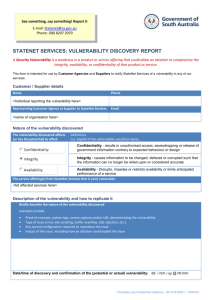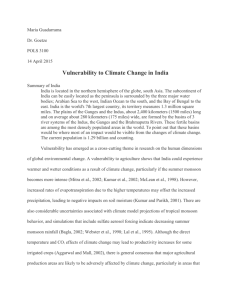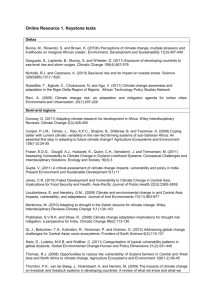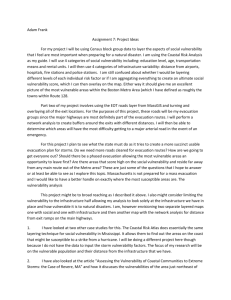Laura`s essay
advertisement
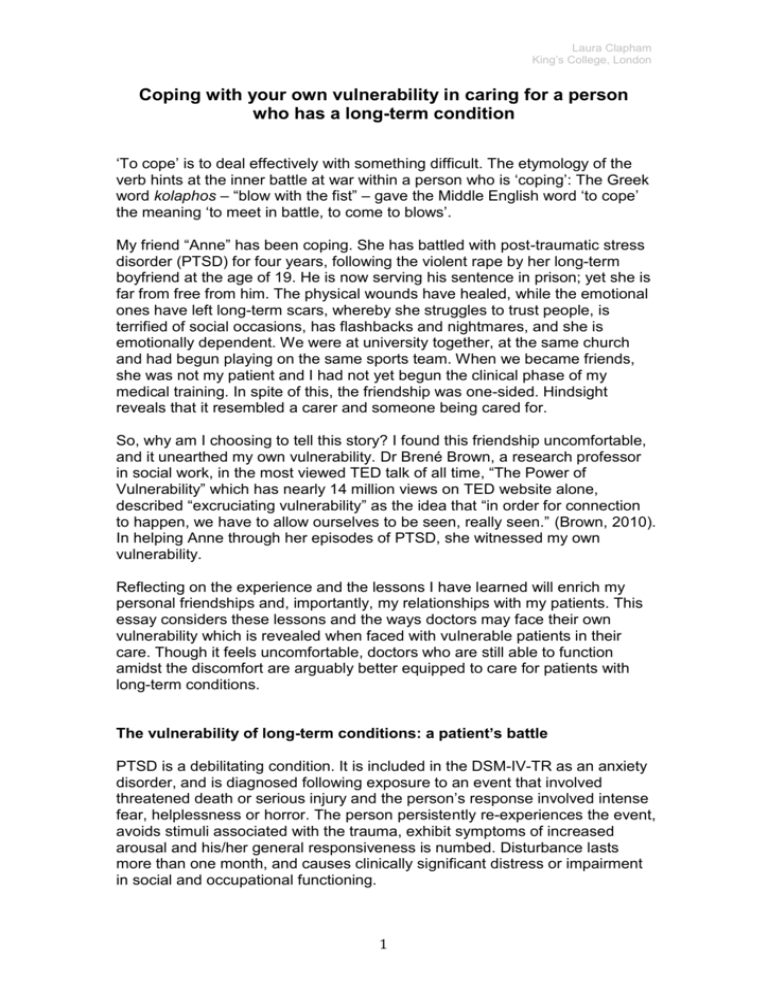
Laura Clapham King’s College, London Coping with your own vulnerability in caring for a person who has a long-term condition ‘To cope’ is to deal effectively with something difficult. The etymology of the verb hints at the inner battle at war within a person who is ‘coping’: The Greek word kolaphos – “blow with the fist” – gave the Middle English word ‘to cope’ the meaning ‘to meet in battle, to come to blows’. My friend “Anne” has been coping. She has battled with post-traumatic stress disorder (PTSD) for four years, following the violent rape by her long-term boyfriend at the age of 19. He is now serving his sentence in prison; yet she is far from free from him. The physical wounds have healed, while the emotional ones have left long-term scars, whereby she struggles to trust people, is terrified of social occasions, has flashbacks and nightmares, and she is emotionally dependent. We were at university together, at the same church and had begun playing on the same sports team. When we became friends, she was not my patient and I had not yet begun the clinical phase of my medical training. In spite of this, the friendship was one-sided. Hindsight reveals that it resembled a carer and someone being cared for. So, why am I choosing to tell this story? I found this friendship uncomfortable, and it unearthed my own vulnerability. Dr Brené Brown, a research professor in social work, in the most viewed TED talk of all time, “The Power of Vulnerability” which has nearly 14 million views on TED website alone, described “excruciating vulnerability” as the idea that “in order for connection to happen, we have to allow ourselves to be seen, really seen.” (Brown, 2010). In helping Anne through her episodes of PTSD, she witnessed my own vulnerability. Reflecting on the experience and the lessons I have learned will enrich my personal friendships and, importantly, my relationships with my patients. This essay considers these lessons and the ways doctors may face their own vulnerability which is revealed when faced with vulnerable patients in their care. Though it feels uncomfortable, doctors who are still able to function amidst the discomfort are arguably better equipped to care for patients with long-term conditions. The vulnerability of long-term conditions: a patient’s battle PTSD is a debilitating condition. It is included in the DSM-IV-TR as an anxiety disorder, and is diagnosed following exposure to an event that involved threatened death or serious injury and the person’s response involved intense fear, helplessness or horror. The person persistently re-experiences the event, avoids stimuli associated with the trauma, exhibit symptoms of increased arousal and his/her general responsiveness is numbed. Disturbance lasts more than one month, and causes clinically significant distress or impairment in social and occupational functioning. 1 Laura Clapham King’s College, London Classically, when faced with an acutely ill patient, a doctor reaches a diagnosis, implements treatment and waits to observe a degree of improvement or a return to baseline. Very often, this process takes place within a short-term timeframe. Evidently, PTSD does not easily fit into this simple flowchart. Indeed chronic conditions require persistent treatment, long-term therapies and a good dose of patience. In line with holistic care, the mental, social and spiritual wellbeing of the patient becomes even more pertinent to their clinical management. Doctors don’t always feel comfortable functioning in the realm of chronic conditions: there is no ‘quick-fix’, hence the doctor may feel helpless, and the patient’s vulnerability is often clearly exposed. Being uncomfortable with others showing vulnerability unveils our uneasiness with our own vulnerability. Chronic conditions provide an excellent arena for confronting and coming to terms with our own vulnerability as medical professionals. But why is it important? Doctors who are able to sit with patients, empathise, and join them in their battles to adapt to life with a longterm condition, ensure patients feel well supported and not alone, which therefore make a huge difference to outcomes. My experience of being friends with Anne urges me to reflect upon the ways in which my own vulnerability was exposed. It provided an opportunity to practise becoming comfortable with being uncomfortable, which should effect better quality holistic care for future patients in my care. My own vulnerability: a doctor’s battle It is difficult to distill the mixture of feelings and thoughts that I have experienced during my friendship with Anne into distinct, digestible entities. However, I have found it useful to identify the feelings and then consider why I felt the way I did. I experienced anxiety and frustration in equal measure. I was afraid of the responsibility of being the only one to help her. I was scared that if I couldn’t help her even a little, I would be failing as a friend. Being vulnerable means being exposed to the possibility of being attacked or harmed, either physically or emotionally. This friendship tested my own ability to cope with these feelings and threatened the security I took from being in control of my own emotions. The responsibility for her wellbeing I had brought upon myself resulted in my feeling helpless and useless. It manifested as my own anxiety and guilt. At the same time I felt frustrated that she was not showing significant improvement in the time I had known her. It felt like we were in a never-ending cycle of dealing with her trust issues. There were moments when I wanted to run away and cut off the pain she was causing in me. These kinds of feelings are common when walking closely with a friend who is going through PTSD. However, things became more complicated when I 2 Laura Clapham King’s College, London began my psychiatry rotation in my medical course. I was torn between understanding her as a person with a disease – I could describe her symptoms using medical words, and her thoughts and actions fitted neatly into a typical pattern for PTSD – and empathizing with her as a friend going through an awful time. Yet doctors who have built rapport with a patient over time may face the same tension. Instead of battling against the two sides, doctors can use the empathy to advise regarding the most appropriate treatment for that specific patient, and use their scientific knowledge to help patients better understand their own conditions and why they may be experiencing sometimes disturbing symptoms. Nurturing a healthy Vulnerability: lessons learned Medical students are trained to become professionals, and eventually to become doctors who stand at a distant so as to make the patient comfortable with revealing personal information and intimate parts of their body for examination. This can make doctors feel like they must be machines who are unaffected by patients’ stories in order to deliver unbiased care and equal healthcare between different patients. Yet it is equally vital that doctors learn to engage as humans, and be comfortable in doing so. Professionalism and distance are necessary tools to good patient care; nonetheless, it is healthy boundaries, constructed and refined through experience, which help us to reconcile this with our own vulnerability. The key to creating healthy boundaries is to come to terms with our own fragility. Every person has the potential to become a patient at some stage in their life. It may seem uncomfortable for doctors to accept that one day they may need to take off their ‘doctor badge’ and become a patient. Yet acknowledging this vulnerability while remaining professional, reliable and consistent doctors requires strength of character. Dr Brown encapsulates this in her description of vulnerability: “Vulnerability sounds like truth and feels like courage. Truth and courage aren’t always comfortable, but they’re never weakness.” (Brown, 2010). I learnt the lesson through a friendship, yet I will take this with me in my future practice. References Brown, B. 2010. "The Power of Vulnerability", research presented at TEDxHouston, Houston, Texas, June. Houston, Texas: TEDx. Please note “Anne” is not her real name. 3


